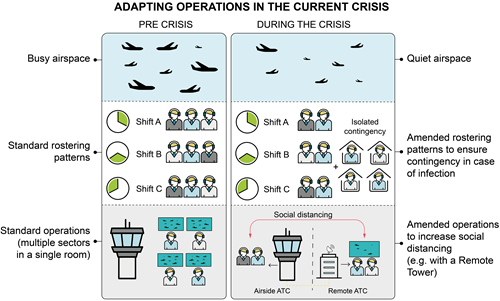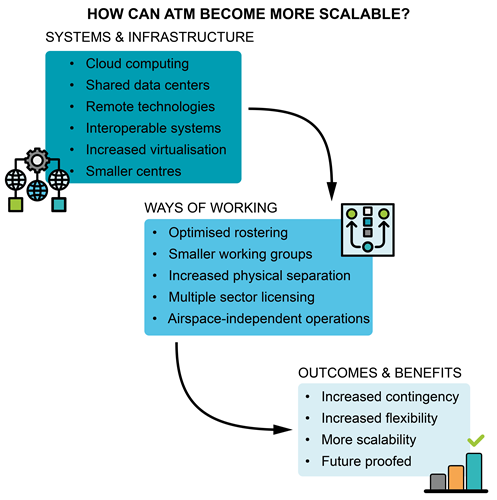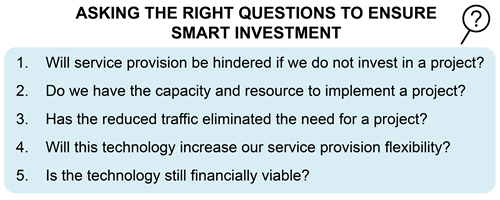
The COVID-19 pandemic has had far-reaching effects on Air Navigation Service Providers (ANSPs) worldwide and we are yet to understand the full extent of the impact. Traffic levels have significantly reduced and, with them, ANSP revenue has fallen. However, Air Traffic Service (ATS) operations continue to support the state and regional response to managing the crisis on a full-time basis. So, ANSPs are faced with the challenges of protecting frontline staff from infection while continuing operations to provide essential services for cargo, repatriation, humanitarian and emergency flights.
FINDING WAYS TO ADAPT - SCALABLE AND RESILIENT INFRASTRUCTURE
To adapt, many ANSPs have already found ways of being flexible by introducing changes to shift patterns to support the health and wellbeing of staff, as well as ensuring appropriate contingency in case of infection. However, this approach to flexibility has only been possible in the reduced demand environment ANSPs are experiencing today. As traffic levels start increasing and a full roster is required, ANSPs will have to look for other ways to boost their operational flexibility.
Real operational flexibility is achieved when new ways of working are supported by an underlying flexible architecture. For example, Hungarocontrol's remote tower in Budapest has allowed for staff to be divided into a remote tower team and a physical tower team, thus enabling social distancing and introducing resilience in a way not possible with traditional physical tower environments.
The ability to merge sectors has been commonplace for a long time, enabling airspace structures to be adapted to suit changing traffic patterns and staff re-deployment. This is capacity-on-demand within a single operational centre. However, real benefits can be achieved where capacity can be scaled across regions. The Airspace Architecture Study, published in March 2019 outlines this as a priority, highlighting that data-sharing across flight information regions within or across state borders and non-geographic ATCO licencing can enable sectors to be handled by different ACCs. This concept exists within Europe. One example of it already being applied, is the Geneva approach, where depending on direction of wind in relation to the runway the traffic is managed by either DSNA or Skyguide – a truly flexible arrangement supported by infrastructure, but also backed by the operational requirement. Can this be achieved at scale within Europe and would it have helped us in the current crisis?
The pandemic has challenged the current perception of which underlying infrastructure will best support flexible ways of working. Currently air traffic control is performed in large rooms containing many people and much has been said in the past about the need to consolidate into potentially even larger centres to become more flexible. However, COVID-19 has raised understandable fears about being in large 'public' spaces, especially indoors, and has fast-tracked trends towards home working – a trend completely at odds with the long-term strategy of consolidating ATC operational centres and the supporting technical systems.
Would it be possible to support working in smaller, more isolated units that could be set up anywhere? This 'new normal' flexible way of working may soon be something that controllers also seek, to support their own health and wellbeing in the aftermath of the pandemic. Initial steps towards enabling this approach are already in motion, for example, Indra's collaboration with Microsoft to move air traffic management to the cloud, which might eventually enable the creation of ATM Data Service Providers (ADSPs). Such an approach will allow ANSPs to decentralise their systems. It also introduces the possibility for ATCOs to provide their service remotely, whilst still retaining the rostering and training benefits of centralising in remote tower centres.
Enaire has already trialled this approach in Spain for remote operational validations with five controllers working from their homes or the ACC using Indra's iTEC system. Although these were operational validations rather than ATS provision, its success shows potential. The question is how far we can go? Will we be constrained by the importance of close controller communication in the delivery of ATS? Important safety/Human Factors issues would need to be addressed; and of course, there are other risks. It exposes traditionally isolated ATC systems towards operating in a "cloud computing" space – with all of the additional cybersecurity considerations that come with that.

TOWARDS SCALABLE INFRASTRUCTURE - HOW FAR AND HOW FAST?
Investment in the technical infrastructure of ATS has focused on sustaining existing systems which were designed for a more monolithic way of working. This, combined with existing national regulations and practices, has meant that flexibility in ATS has been difficult to achieve - the service lacks scalability.
The Airspace Architecture Study reignited the discussion about creating flexibility in our service offerings through changes to the way we manage data within the ATS architecture. The latest version of the European ATM Master plan published in December 2019, also has scalability and resilience at its core to enable a vision where ATS operations can adapt to traffic levels as required.
The current crisis has brought infrastructure scalability further into focus, illustrated by the European Commission's announcement that it is planning to promote principles from the Airspace Architecture Study in the SES2+ reform; highlighting the need to push towards ATM Data Service Providers (ADSPs) and further cooperation between ANSPs, whilst introducing the opportunity of opening the market to new entrants.
The Airspace Architecture Study and the expected outcomes of SES2+ promise progress, but ANSPs will have to support the change. As the COVID-19 pandemic changes perceptions, will it add impetus towards creating the new architecture? And should ANSPs be re-considering their operational and technical strategies to implement these ideas at a faster pace?

As an industry, aviation is not naturally innovative. The tendency has been to set resilience margins and only start planning investments when these margins start to erode – normally because system lifecycle planning has failed to defend the need to invest in new technologies. The result is firefighting, and the investment in keeping systems going simply builds reliance on the status quo. The traditional rationale for maintaining the status quo was that it was the less risky path to use proven technology. However, there's an argument that this conservative approach has increased the risk exposure. Surely the current situation has showcased the benefits, opened up opportunities and tipped the balance toward accelerated deployment of new solutions?
IT'S TIME TO REPRIORITISE INVESTMENT
ANSPs are now in a position where they need to review their Capex programmes. Nervousness about investment in the current environment will be natural, particularly given cash shortfalls associated with the current reduction in revenue. But is this the right time to stop investing? Decisions now on investment will see the benefits realised in three to five years or beyond, when the aviation industry might expect to see a return to traffic levels seen in 2019. Reprioritising investment now to bring about more flexibility will ensure that ANSPs are more prepared and resilient to traffic volatility, which is likely to remain part of traffic patterns in the coming years. In addition, although revenue is reduced, so is the traffic and therefore any infrastructure improvements can be completed at much lower operational risk.

PLANNING FOR RESILIENCE
The challenge of the current crisis will result in a significant change of direction in organisational strategies. It has exposed limitations in the current approach to crisis management, contingency operations, infrastructure design and business planning but also showcased the benefits and opportunities of investing in new solutions. Very few ANSPs have resilience plans for the loss of an entire shift or the inability to practically isolate an entire shift from a threat. Flexibility in licencing, supported by a configurable system and efficient data sharing would lay the groundwork for ATCOs to provide a service in any airspace. This in turn would enable new ways of working adapted to the operational need, greater optimisation of ATCO rostering and more resilience in the case of such a crisis as the one we are facing today. Perceptions of staff as well as management will have evolved, and system changes coupled with new ways of working and changes to the underlying regulation could result in a step change. As we emerge from the COVID-19 pandemic, we need to re-plan for resilience in our business models, service offerings, physical and virtual infrastructure and importantly, our people.






.png)
.jpg)


